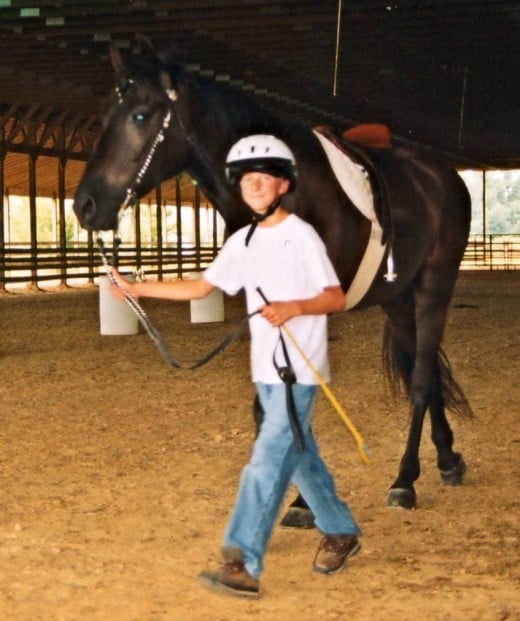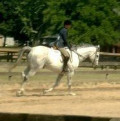Leading, The Core Building Block of Horse Training
Leading Your Horse is Basic to all Training
Leading is your main building block on which all other training depends. These first lessons establish your role with your horse as the alpha in your herd of two – you and the horse. When this is done right the rest of the training goes smoother and makes sense to your horse.
The equipment you need is minimal: a halter, a lead rope, and a longe or carriage whip. Your goal is to teach your horse that he has two responsibilities: to stay perpendicular to you (not swinging its hips away or toward you) and to stay with its throatlatch even with your shoulder at all times. It is a good idea to work within an enclosed area if your horse is young or has never been led, in case he pulls away from you. A round pen is great, but any enclose area will work. This is for the horse’s safety, so that if he gets away from you he cannot run out into a road or other dangerous area.
A Well Trained Horse that is Safe to Handle

Leading Teaches Horse Obedience
Leading teaches obedience and teaches the horse to move forward. Moving forward is an important lesson when riding or driving. Anytime you have a problem in that area go back to your leading lessons to correct it.
Now, we are ready to proceed with the leading lessons. First, stand at the horse’s left shoulder/throat latch area, facing the direction you intend to go. Your right hand is on the lead rope about six inched below the snap (never hold onto the snap, that is very dangerous in case the horse snatches away), hold the excess lead rope in a loop in your left hand, and hold the whip in your left hand. The whip should always be pointed behind you and toward the ground, so not to worry or excite the horse.
Now, step forward, looking where you are going. Do not turn your head and look at the horse. This will intimidate him and can cause him to stop or lag behind. He should step off the exact moment you step forward. If he does not, reach back and tap his “ankles” with the whip. If he still does not move, tap a little harder the second time. If it takes a third time tap smartly and make sure you get him moving. If you have to go to the third tap chances are good the horse will lunge to far forward or turn away from you.
If he does rush forward tug sharply on the lead rope with your right hand. Give a sharp voice command like, “no” or “slow down” or anything except whoa, because you don’t want him to stop, just slow back to your pace. Again, it may take a second or third tug. Increase the pressure each time until he is walking beside you in the correct position.
If the horse tried to turn toward you and swing his hips away (this is an avoidance movement) just push on the lead rope with your hand going under the horse’s jaw turning the front of the horse away, stepping toward him, until he is standing perpendicular to you again. You just calmly repeat this anytime he gets out of position until he learns where he should be. Then ask him again to move forward.
Your horse should stay at your shoulder at all times, stepping out with you as you step forward, back, turn, jog, anything you ask him to do the horse must stay at your shoulder keeping at your pace. Be sure that if he is going faster than you are that you do not speed up, but demand that he slow down. You are not the alpha if your horse is setting the pace. The same is true if he lags behind. Use the whip to move him up faster to keep pace with you.
Whenever you want the horse to stop and stand still you should stop and turn so your toes point toward the horse’s shoulder and say, “Whoa.” If he does not stop, tug on the lead and repeat, “Whoa.” Eventually the horse will know when you stop he stops, and when you turn toward him he is to stand still.
Once your horse gets the idea and is leading well vary your routine, stop, start, turn, jog, and walk over obstacles. Vary your pace. When you turn always turn the horse away from you using the same technique for correcting him turning his head to you. Push the lead under his jaw and walk toward him. If he doesn’t step to the side to turn use your other hand to push his shoulder away. As soon as he moves in the correct direction release the pressure. Soon he will turn as soon as you step toward him because he is paying attention to your body language. Practice quart, half and full 360 degree turns. Ideally, the horse will pivot on his hind legs and his front legs will cross over and he steps around. This is good basic training for the turn on the hindquarter, only when riding the horse is moving away from your leg pressure.
Once he is consistence in his obedience you can take the horse outside your work area and walk along some trails, since stopping, turning and jogging.
When your horse thinks of you as his leader he also thinks of you as his protector and that is when the trust begins to come back. Anytime you run into a training problem, on the ground or under saddle, go back to your basis leading lessons.
These horse training exercises can be done in the barn aisle when the weather is too bad to work outside. Anytime you can snatch ten of fifteen minutes you can work on your horse’s leading lessons. Be creative and make up patterns and routines. All this work will pay off when you ride whether on the trails or in the show ring.
© 2008 Donna Campbell Smith








